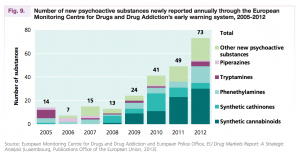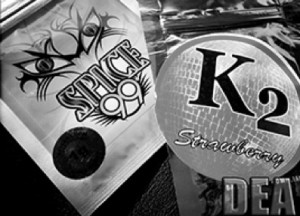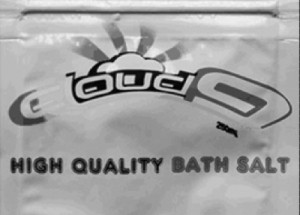The Problems With Synthetic Drugs
The War on Drugs rages on. New “designer drugs” – synthetic cannabinoids and synthetic cathinones – are the latest drug craze to hit the U.S., and law enforcement have a new set of problems to deal with.
Synthetic pot, often referred to as “Spice,” “K2,” or “(No More) Mr. Nice Guy,” first showed up in the UK roughly a decade ago. The American Association of Poison Control Centers reports effects from synthetic pot use started showing up in the states in 2009. Use of synthetic cathinones, usually called “bath salts,” showed up at roughly the same time.
“Our data shows increased use in 2010 which has tapered off for both synthetic cannabinoids and bath salts,” says Dr. James Mowry, director of the Indiana Poison Center. “But we have voluntary reporting and as people become more familiar with these products, they may not call us.”
According to Paul Heaton of the Warsaw Police Department, the drugs have shown up in the local area in the last five years, and use has increased dramatically since.
Synthetic pot, obviously, mimics the effects of marijuana. In most cases, it’s produced by spraying psychoactive chemicals on herbs. It’s typically marketed as “herbal incense” or even potpourri.
Bath salts are crystalline powders, resembling epsom salts, thus the name, that have similar effects to stimulants like cocaine, meth or MDMA. They can be swallowed, snorted, smoked, or injected.
The chemical compounds in these products – of which there are many – that get users high were originally research chemicals never intended for human use. Little is known about how the human body metabolizes these substances
“Synthetic cannabinoids stimulate the cannabinoid receptors in the brain,” says Mowry. “The various bath salts affect serotonin, dopamine and norepinephrine (all neurotransmitters) to varying degrees depending on the particular substance.”
Effects of using the substance can vary, as the chemical compounds vary, and each user is different. For some, it can be relatively harmless, causing giddiness, mild paranoia or increased heart rate and blood pressure. For others, it could cause a trip to the ER.
“Kidney failure is one of the problems. Another is either precipitating or unmasking psychosis,” Mowry says. “In addition, some of these compounds can cause seizures.” Studies at the University of South Florida have found Spice use to correlate with strokes in young people.
“There’s so many different variables in this drug that we haven’t been able to lock down what happens,” says Heaton. “You never know what you’re going to get.”
In April, a Warsaw man believed to be under the influence of a synthetic cannabinoid attempted to bite off a woman’s thumb and attacked a police officer. He was eventually taken down by a WPD K9 unit.
“Everybody reacts differently to it,” says Heaton. “Some go crazy, some go into seizures. There’s not one thing that happens that’s the same in any one individual.”
So, if reactions to these drugs can be so traumatic, why do people use them? Well, for one, they can get away with it.
The chemical compounds in these synthetic drugs currently don’t show up on standard drug screenings. In most cases, someone could smoke Spice one night, take a pre-employment drug screening the next day and the results would come back clean.
“There are several special drug screens now available for both bath salts and synthetic marijuana’s, but it is a moving target,” Mowry says. “There are hundreds of compounds being synthesized and what is popular now may not be in 6 months.”
 Furthermore, despite the fact that these substances are illegal, outlawed by the passing of the Synthetic Drug Abuse Prevention Act of 2012, and the Drug Enforcement Agency has been cracking down on them, they are still readily available. “Many of the base molecules have been outlawed already, but again, it is a moving target,” says Mowry.
Furthermore, despite the fact that these substances are illegal, outlawed by the passing of the Synthetic Drug Abuse Prevention Act of 2012, and the Drug Enforcement Agency has been cracking down on them, they are still readily available. “Many of the base molecules have been outlawed already, but again, it is a moving target,” says Mowry.
“We’ve been pretty aggressive in enforcing it, once the laws were in place to do so,” Heaton says. “We’ve worked with the prosecutor quite well about how to address it. Every situation that comes up, we handle it.”
When Stimmelator’s Gentleman’s Club and California Dreamin’ in North Webster were raided last year, substantial amounts of synthetic drugs were found. A number of arrests resulted from complaints of synthetic drug activity and an ensuing investigation at the now defunct The Underground in Warsaw last year, and there have been several busts at the Katie’s Kwik-Mart in Leesburg for selling synthetic drugs.
“Our county has been pretty proactive,” says Heaton. “Most of the people are getting it from outside of the county and bringing it back in.” These drugs can also easily be ordered on the Internet.
 The fact remains, synthetic drugs, along with meth, heroin and prescription drug abuse, are a surging problem in Indiana and the Midwest. The DEA recently reported northern Indiana and southern Michigan have an especially severe drug problem. According to Heaton, often times the use of designer drugs go hand-in-hand with substances like meth.
The fact remains, synthetic drugs, along with meth, heroin and prescription drug abuse, are a surging problem in Indiana and the Midwest. The DEA recently reported northern Indiana and southern Michigan have an especially severe drug problem. According to Heaton, often times the use of designer drugs go hand-in-hand with substances like meth.
“Most of our meth users have spice also,” Heaton reports. “Usually if we arrest somebody with meth, they have spice paraphernalia on their person.”
More alarming, these drugs are shown to be popular with young people. According to the National Institute on Drug Abuse, of the 11,406 ER visits in 2010 associated with synthetic pot, 75 percent were between the age of 12 and 29. In 2012, the NIDA reported 11 percent of high school seniors used synthetic pot.
“We’ve had people say it’s more addictive than the harder drugs,” says Heaton. Effects of the come-down and/or withdraw, especially in the case of bath salts, from these substances can be rough.
Ultimately, though, users are going to do what they want to do – whether it’s illegal or not. As long as they can get their hands on this stuff, some people are going to use it.
So, until law enforcement can find a way to snub this issue at the source, either the chemists synthesizing these products or the retailers making it available, controlling synthetic drugs is going to be something like a game of Whack-A-Mole.


